ASRock M8 Barebones Review: My Steam Box
by Ian Cutress on January 2, 2014 10:00 AM EST- Posted in
- Barebones
- Intel
- ASRock
- Motherboards
- Cases/Cooling/PSUs
- Z87
Because it can be difficult to benchmark a barebones, due to our choice in hardware overriding any performance results, I wanted to run my usual CPU benchmark suite to at least indicate where a CPU such as the i7-4765T would perform, given its lower CPU MHz base (2.0 GHz) but highly multithreaded nature. The CPU itself performs well, and outstretches almost all the AMD CPUs in every benchmark, sometimes being eclipsed by the FX-8350 in specific workloads.
Point Calculations - 3D Movement Algorithm Test
The algorithms in 3DPM employ both uniform random number generation or normal distribution random number generation, and vary in various amounts of trigonometric operations, conditional statements, generation and rejection, fused operations, etc. The benchmark runs through six algorithms for a specified number of particles and steps, and calculates the speed of each algorithm, then sums them all for a final score. This is an example of a real world situation that a computational scientist may find themselves in, rather than a pure synthetic benchmark. The benchmark is also parallel between particles simulated, and we test the single thread performance as well as the multi-threaded performance.
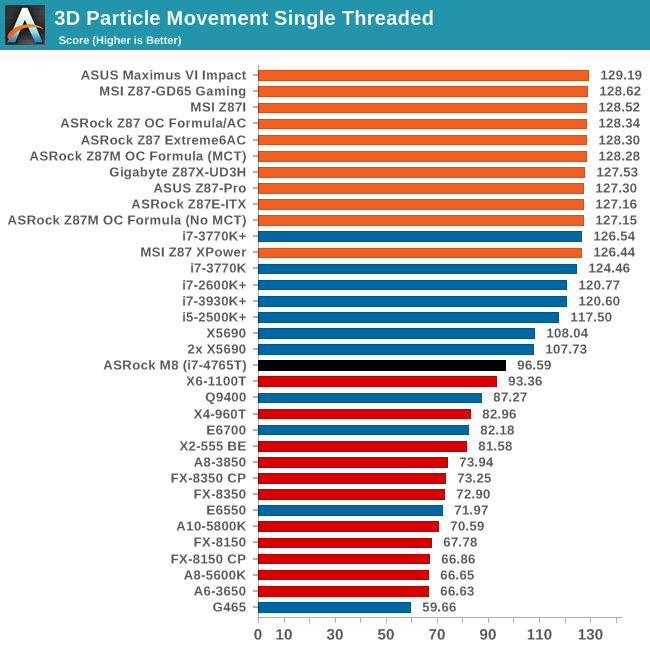
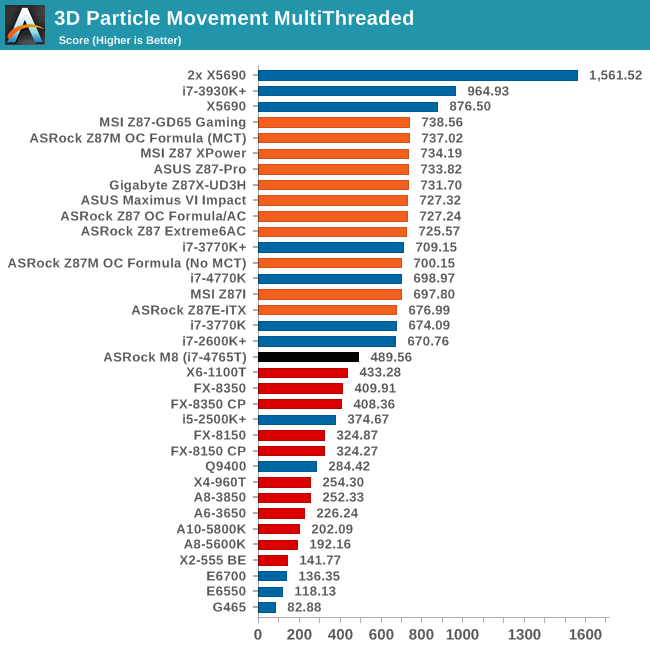
Compression - WinRAR 4.2
With 64-bit WinRAR, we compress the set of files used in the USB speed tests. WinRAR x64 3.93 attempts to use multithreading when possible, and provides as a good test for when a system has variable threaded load. WinRAR 4.2 does this a lot better! If a system has multiple speeds to invoke at different loading, the switching between those speeds will determine how well the system will do.

Image Manipulation - FastStone Image Viewer 4.2
FastStone Image Viewer is a free piece of software I have been using for quite a few years now. It allows quick viewing of flat images, as well as resizing, changing color depth, adding simple text or simple filters. It also has a bulk image conversion tool, which we use here. The software currently operates only in single-thread mode, which should change in later versions of the software. For this test, we convert a series of 170 files, of various resolutions, dimensions and types (of a total size of 163MB), all to the .gif format of 640x480 dimensions.
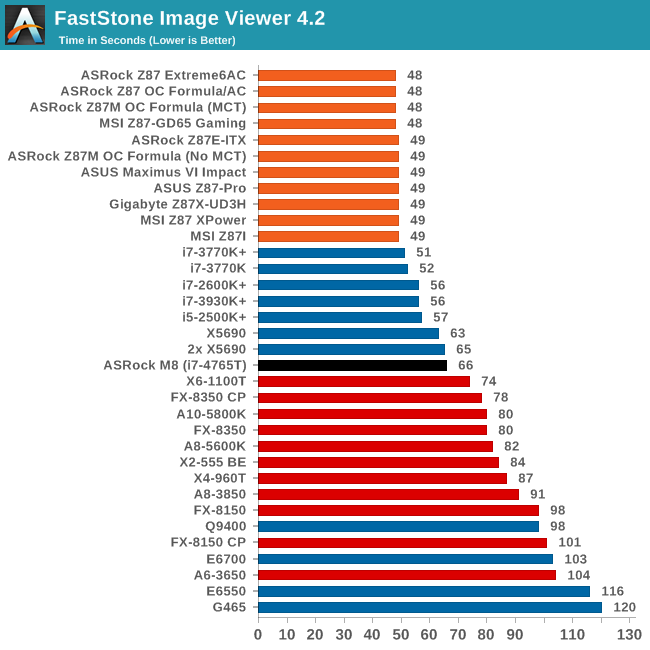
Video Conversion - Xilisoft Video Converter 7
With XVC, users can convert any type of normal video to any compatible format for smartphones, tablets and other devices. By default, it uses all available threads on the system, and in the presence of appropriate graphics cards, can utilize CUDA for NVIDIA GPUs as well as AMD WinAPP for AMD GPUs. For this test, we use a set of 33 HD videos, each lasting 30 seconds, and convert them from 1080p to an iPod H.264 video format using just the CPU. The time taken to convert these videos gives us our result.
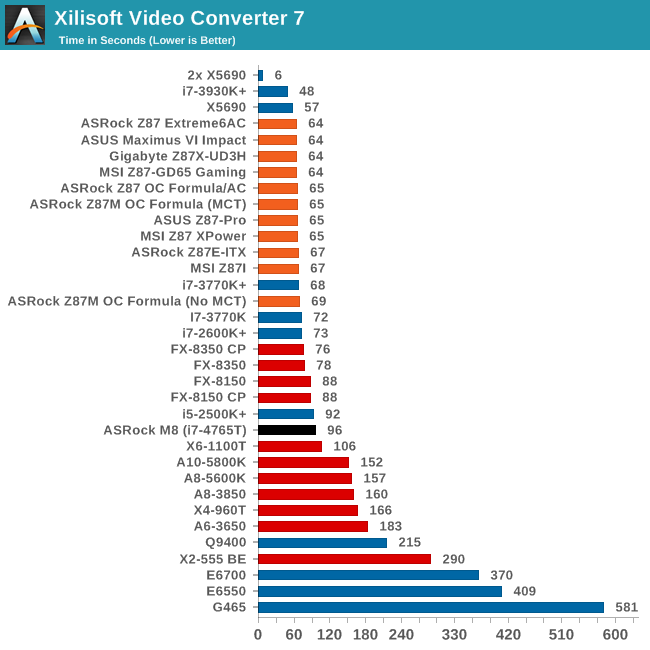
Rendering – PovRay 3.7
The Persistence of Vision RayTracer, or PovRay, is a freeware package for as the name suggests, ray tracing. It is a pure renderer, rather than modeling software, but the latest beta version contains a handy benchmark for stressing all processing threads on a platform. We have been using this test in motherboard reviews to test memory stability at various CPU speeds to good effect – if it passes the test, the IMC in the CPU is stable for a given CPU speed. As a CPU test, it runs for approximately 2-3 minutes on high end platforms.

Video Conversion - x264 HD Benchmark
The x264 HD Benchmark uses a common HD encoding tool to process an HD MPEG2 source at 1280x720 at 3963 Kbps. This test represents a standardized result which can be compared across other reviews, and is dependent on both CPU power and memory speed. The benchmark performs a 2-pass encode, and the results shown are the average of each pass performed four times.
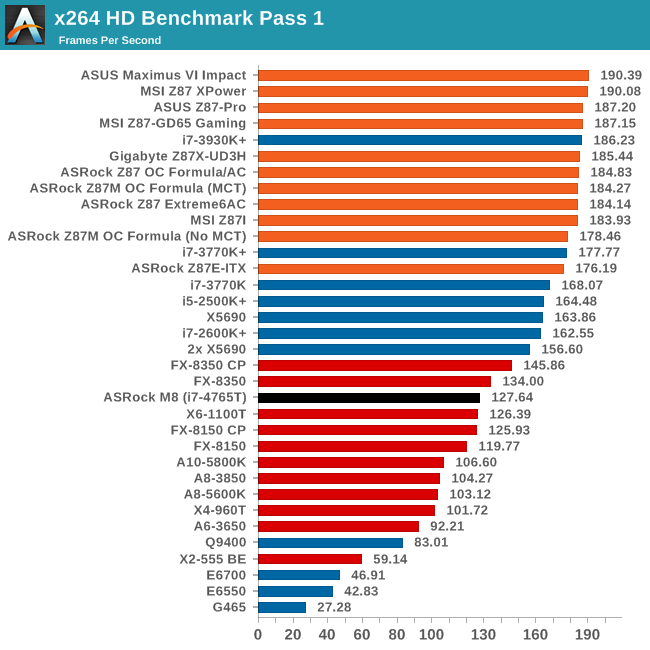
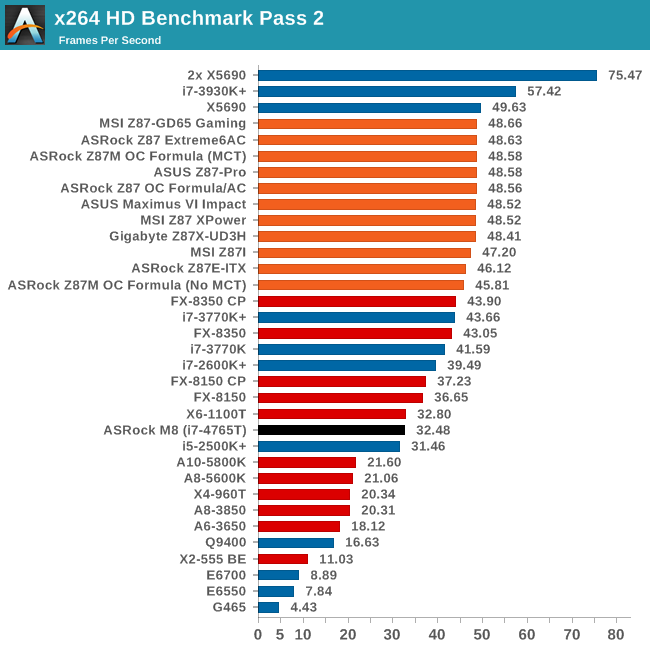
Grid Solvers - Explicit Finite Difference
For any grid of regular nodes, the simplest way to calculate the next time step is to use the values of those around it. This makes for easy mathematics and parallel simulation, as each node calculated is only dependent on the previous time step, not the nodes around it on the current calculated time step. By choosing a regular grid, we reduce the levels of memory access required for irregular grids. We test both 2D and 3D explicit finite difference simulations with 2n nodes in each dimension, using OpenMP as the threading operator in single precision. The grid is isotropic and the boundary conditions are sinks. Values are floating point, with memory cache sizes and speeds playing a part in the overall score.
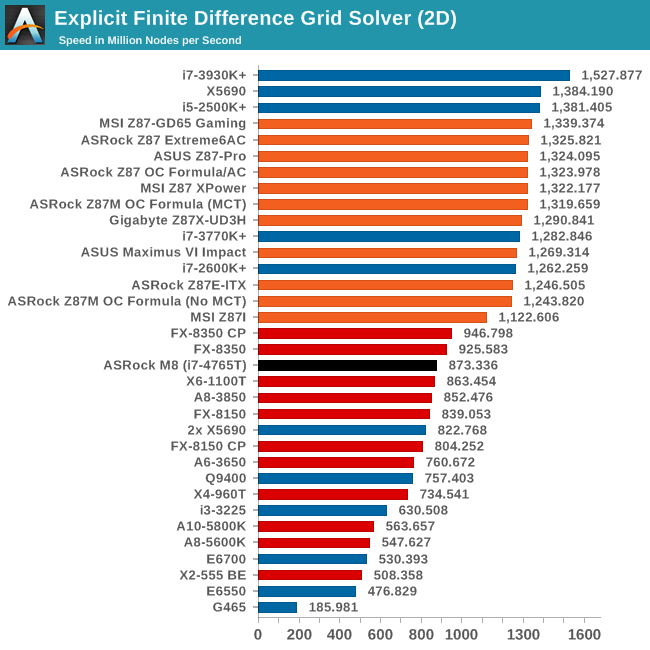
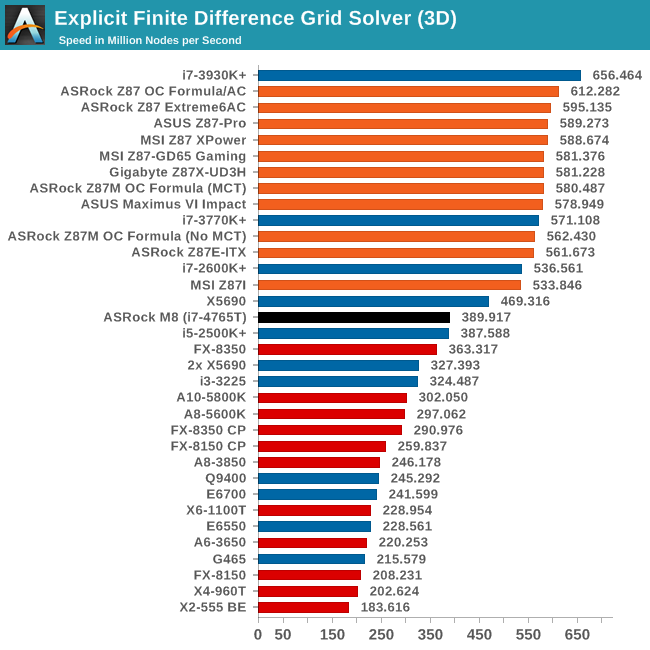
Grid Solvers - Implicit Finite Difference + Alternating Direction Implicit Method
The implicit method takes a different approach to the explicit method – instead of considering one unknown in the new time step to be calculated from known elements in the previous time step, we consider that an old point can influence several new points by way of simultaneous equations. This adds to the complexity of the simulation – the grid of nodes is solved as a series of rows and columns rather than points, reducing the parallel nature of the simulation by a dimension and drastically increasing the memory requirements of each thread. The upside, as noted above, is the less stringent stability rules related to time steps and grid spacing. For this we simulate a 2D grid of 2n nodes in each dimension, using OpenMP in single precision. Again our grid is isotropic with the boundaries acting as sinks. Values are floating point, with memory cache sizes and speeds playing a part in the overall score.
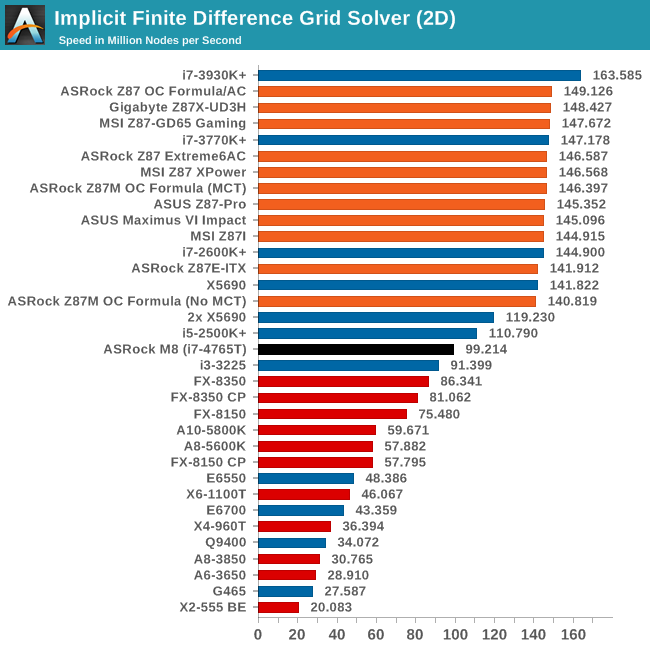
Point Calculations - n-Body Simulation
When a series of heavy mass elements are in space, they interact with each other through the force of gravity. Thus when a star cluster forms, the interaction of every large mass with every other large mass defines the speed at which these elements approach each other. When dealing with millions and billions of stars on such a large scale, the movement of each of these stars can be simulated through the physical theorems that describe the interactions. The benchmark detects whether the processor is SSE2 or SSE4 capable, and implements the relative code. We run a simulation of 10240 particles of equal mass - the output for this code is in terms of GFLOPs, and the result recorded was the peak GFLOPs value.
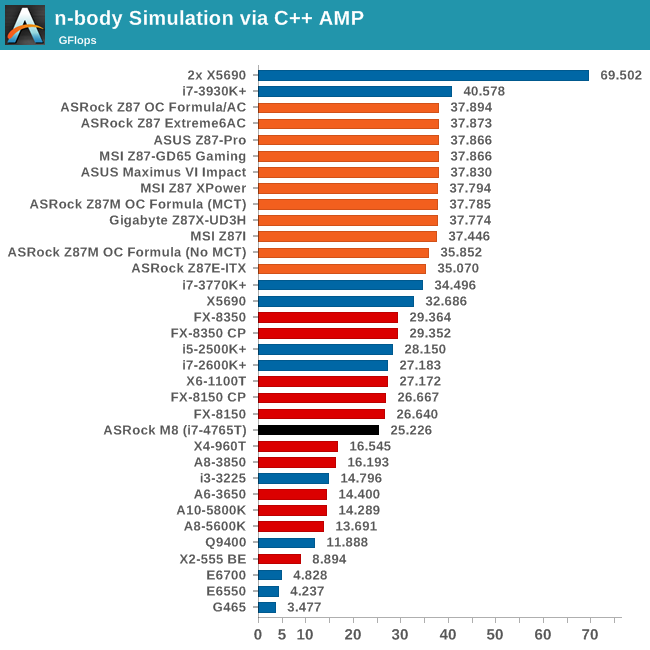










78 Comments
View All Comments
mwildtech - Thursday, January 2, 2014 - link
50' HDMI cable, Wireless Xbox 360 controller and Steam Big Picture = My Steam BoxBPB - Thursday, January 2, 2014 - link
That would be me too. The 360 wireless setup is great!56tb - Thursday, January 2, 2014 - link
Tek Syndicate did a video of this, you can find it on youtube. They went into a lot of detail on thermals and suchlike, so worth checking out. They even used a Velociraptor to add some extra heat to the mix.pirspilane - Thursday, January 2, 2014 - link
I bought an ASRock barebones system and would recommend steering clear of this. Their techs are either grossly incompetent, dishonest, or both. If you get one with a defect, they will claim your memory, processor, assembly (take your pick) is the problem and give you the runaround. You will waste endless hours of your precious time dealing with their ineptitude, not to mention the cost and time of trips to UPS.Sivar - Thursday, January 2, 2014 - link
Please change the photographs in the article to JPG format.PNG is the best format by far for line art, technical drawings, charts, screen captures from Excel, -- anything without a lot of random color variability -- but is an absolutely terrible format for website photographs.
The images load slowly and many mobile users have to pay for bandwidth past a certain point.
IanCutress - Thursday, January 2, 2014 - link
Noted for the future.nerd1 - Thursday, January 2, 2014 - link
At such a price, it actually seems more logical to get a powerful gaming laptop. You can spend $2K to get a 17" gaming laptop with QC cpu, 780M, SSD and that is actually mobile.nunomoreira10 - Thursday, January 2, 2014 - link
So true, win everywhere.Death666Angel - Monday, January 6, 2014 - link
That 780M is about as fast as a GTX 660TI, which is a bit more than half as powerful as some GTX 780 / R9 290X cards, which you can fit in here (450W is fine for the current crop of high end cards as long as your CPU isn't OC'ed to the max).So I don't see how there is even the slightest comparison. And once you get into 780M SLI territory, you are way up there in price.
cgalyon - Thursday, January 2, 2014 - link
I've read elsewhere that the default fan configuration is not ideal (because they are oriented one up, one down in the top and bottom of the case). Has AsRock changed this? I would like a more detailed look at us thermal characteristics of the case of possible, as it was one of the main things holding me back (the other being weight).Also, I would like to see a review comparing this case to another barebones case, the Shuttle SZ86R6. Don't know how feasible that would be...